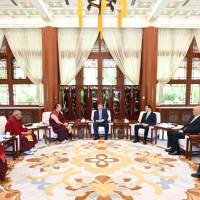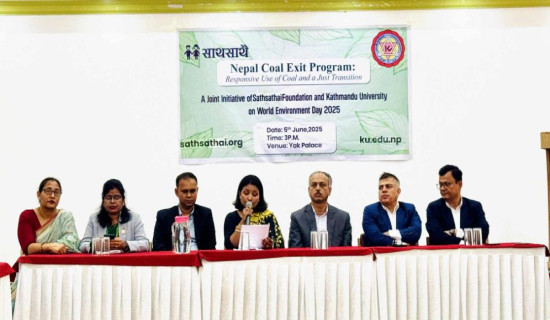- Saturday, 7 June 2025
A Comprehensive Treatise On Indian Finance Ministers
While every government is composed of various ministries of importance and standing, and their political heads assume significance and theoretically enjoy equal authority, standing, privileges, and perks, there is absolutely no doubt that some ministries and ministers are more equal than others. This assumption is more applicable in the case of some ministries, like finance, in most countries. It is in this aspect that finance ministers of India are justly taken as powerful figures with quite an influential clout in the overall policy formation and implementation of the government and even on the prime ministers they serve.
It is in this context that the book authored by a senior intellectual and seasoned journalist of prominence with the advantage of having a ringside view of the government at large, A. K. Bhattacharya, assumes considerable importance. The work entitled India's Finance Ministers: From Independence to Emergency (1947–1977) covers the study of what the prolific writer tends to define as the first thirty eventful years that pertain to the economy and many public institutions involved in India's economic governance.
This is the author's second work after his first book with a telling title, The Rise of Goliath: Twelve Disruptions that Changed India, became quite popular. The new book encompasses a comprehensive treatment of ten finance ministers, including two prime ministers, Jawaharlal Nehru and Indira Gandhi, who held the portfolio concurrently as more of a stop-gap arrangement following the abrupt absence of their finance ministers, who resigned under different circumstances, with both substantive and anecdotal references.
Besides, Bhattacharya has deemed fit to deal with finance ministers of the first three decades of Indian independence on the basis of what can be called a case analysis approach, either relating to their major achievement or circumstances that forced their ouster from the prestigious office.
Out of what can be called eight stand-alone or full-fledged finance ministers of the pre-1977 period, two of them, T. T. Krishnamachari and Morarji Desai, had two tenures, the first having served the first two Prime Ministers of India, Nehru and Lal Bahadur Shastri, and the second serving under both Nehru and his daughter and third Prime Minister Indira Gandhi.
Among the Finance Ministers of the period under review, only Morarji Desai, who holds the record of being in the post for the longest period if his two terms are taken into account, became Prime Minister later after obviously being denied the opportunity at least twice, when Nehru and Shastri died in 1964 and 1966, respectively.
Yashwantrao Chavan, with seemingly all the potential to become the Prime Minister and an impressive experience of freedom struggle, Maharashtra's cooperative leader, the state's first Chief Minister, and one who held all important portfolios like Home, Defence, External Affairs, and Finance at the centre, was not that lucky, as he had to be satisfied with being the fifth Deputy Prime Minister under what can be called a lame duck government during the premiership of Chaudhary Charan Singh.
In later periods, there were two finance ministers. Pranab Kumar Mukherjee, who was also in the post for more than six years in two tenures, and Ramaswamy Venkataraman took over as the eighth and thirteenth Presidents of India, respectively. Among other finance ministers in the post-1977 era, prime ministership came to embrace Charan Singh, Vishwanath Pratap Singh, and Dr. Manmohan Singh in recent years.
Likewise, two of the 25 Finance Ministers who have served the country so far tried their luck rather unsuccessfully for the position of President, with one sheer coincidence that both came from bureaucracy: Sir Chintaman Deshmukh in 1969, when V.V. Giri was elected, and Yashwant Sinha, who was trounced by Droupadi Murmu in 2022.
Deshmukh, an intellectual and institution-builder who was also the first ICS officer and first Indian Governor of the Reserve Bank of India to hold the post and gave the first Convocation Speech to Tribhuvan University, had the longest uninterrupted tenure during the period, a record that has remained unsurpassed even after almost 77 years of Indian independence.
The highly readable book is divided into eleven chapters dealing with nine finance ministers, with two of them having non-consecutive tenures as already described, with a very good prognosis of the problems they inherited and confronted and measures they undertook for the benefit of the economy, getting what can be called bouquets and brickbats for the initiatives they took and failures they achieved in the course of their stints.
Incidentally, Nehru was in the saddle of Prime Minister after independence for almost seventeen years, and even close to eighteen years if his stewardship of the country as de facto prime minister during the interim period is also counted. He had as many as six finance ministers, with two having two tenures, a record that is yet to be broken when at least three other prime ministers had longer tenures with Indira Gandhi for more than sixteen years and Dr. Man Mohan Singh and Narendra Modi surpassing ten years in their positions.
One major takeaway from the book is that Indian prime ministers have rarely taken additional charge of the finance ministry, unlike that of external affairs during Nehru's time, as he consistently refused to appoint a full-fledged external affairs minister, except as an interim measure and under circumstances when incumbent finance ministers left the job.
One interesting aspect of the book is that it carries no concluding observations despite having a comparatively short introduction. Two obvious lacunae in the work are the failures to include the names of Kshitish Chandra Neogy and Pandit Jawaharlal Nehru in the contents.
The writer might have ignored the first, as he was the second Finance Minister, but stayed in his post for a very short period of 36 days, from August 18 to September 22, 1948, and thus did not play any major role in the country's economic governance. Likewise, Pandit Nehru, who presented his government's budget for 1958–1959, is dealt with subsequently, though not included in the contents.
Except for these two quite insignificant points, the book is a great work as it unravels the circumstances under which finance ministers were appointed and were either forced to quit or offered to leave the positions following perceptional differences with their political bosses. I congratulate the author for the wonderful and tenaciously hard work he has put into bringing out this remarkable publication.
(Dr. Bhattarai is a former Foreign Secretary and ambassador. kutniti@gmail.com)






-original-thumb.jpg)










